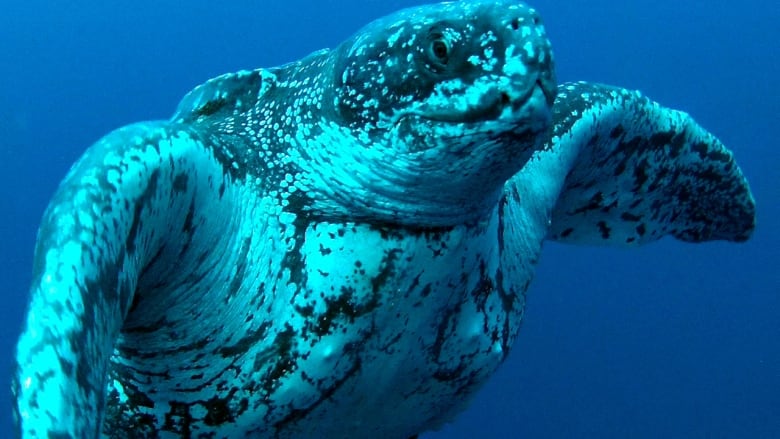Rare endangered leatherback sea turtles spotted off P.E.I.
'It was overwhelming — they were amazing'
It was a sight lobster and tuna fisherman Lorne Bonnell had never seen before — in mid-August, the North Lake fisherman spotted more than a dozen leatherback sea turtles in the water about 10 kilometres off the coast of P.E.I.
- Video of shark off P.E.I. racking up views quickly
- Nova Scotia asks Ottawa to stop protecting new marine areas
The endangered turtles are known to migrate to the waters of the southern Gulf of St. Lawrence and the Northumberland Strait at this time of year to feed on jellyfish, according to the Department of Fisheries and Oceans.
We were super excited about them.— Kathleen Martin, Canadian Sea Turtle Network
Bonnell said at first, it looked like seal heads popping up.
"As we got closer we noticed they weren't seals, they were turtles!" he said.
He quietly glided his boat beside the group, noticing the largest one — about the size of a picnic table, he said — munching on a large jellyfish. He grabbed his phone and began snapping pictures. He has never seen a leatherback before.
"They were massive! They were way bigger than I ever expected," he said.
The turtles weren't thrilled about being so close to the boat, Bonnell noted, and dove down, moving away.
"It was overwhelming — they were amazing."
'Amazing photographs'
The Canadian Sea Turtle Network is excited about Bonnell's sighting, too.
The Halifax-based non-profit research and conservation group has posted information in every port in the Atlantic region asking the public to report sightings, which is what Bonnell did.

"They're amazing photographs — they're some of the most wonderful photographs of turtles feeding on jellyfish that we've seen," said the network's executive director, Kathleen Martin.
Bonnell was "extremely lucky" to see so many at once, she said
Ancient species
Bonnell has given permission for the network to use his photos in its promotional materials.
"It takes people who are used to being on the water like Mr. Bonnell to be able to spot them," Martin noted. "It's not commonplace to see them, but it's not unusual that they're there."

The turtles gain a third of their body weight on their summer visits, she said, which helps fuel their return to southern locales like South America, the Caribbean and Florida for nesting.
'Critical to the survival'
"This is why Atlantic Canadian waters are so critical to the survival of leatherback turtles, because this is where they bulk up on jellyfish," Martin explained.

She believes the large leatherback Bonnell snapped was eating a lion's mane jellyfish, the largest breed of jellyfish in the world.
The main threats to the prehistoric turtles are entanglement in fishing gear and ingesting marine debris, like plastic bags that resemble jellyfish, Martin said, adding there are also threats in their nesting regions like beach-front development and poaching for their eggs and meat.
Much is still unknown
Much is still unknown about the species — it's remained virtually unchanged for the last 150 million years — including how long they live and how old they are when they typically reproduce, Martin said.
Bonnell has caught a lot of big fish, including tuna and sharks, but said seeing the turtles was one of his favourite marine experiences.
"I take tours out, too — I'm sure people visiting the Island would love to see something like that," Bonnell said.
The turtles will soon begin to migrate south to warmer waters, where they spend the winter, the sea turtle network said.
- MORE P.E.I. NEWS | 'Like a heavy fog': P.E.I. man waiting for cataract surgery for months
- MORE P.E.I. NEWS | Half of P.E.I. psychiatrist positions filled by actively working doctors says province

